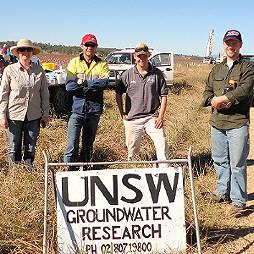Posted 18 June 2012

UNSW-NCGRT research team and the groundwater sampling trailer at Yarramanbah site (from left to right: Dr Wendy Timms, Hamish Studholme, 4th year student Mark Bryan, Dr Adam Hartland)
A field research campaign was completed during May 2012 by an NCGRT team investigating the role of low permeability sediments in groundwater systems in the Upper Namoi catchment of the Murray-Darling basin.
The field campaign provided training experience for five NCGRT Honours students, led by postdoctoral researchers Dr Adam Hartland and Dr Anna Greve and a Chief Investigator Dr Wendy Timms. UNSW staff including NCGRT's Dayna McGeeney were responsible for working with the NSW Office of Water Drillers.
This work achieved a significant milestone, with the successful completion of coring and monitoring installations as part of the NCGRT aquitard research program.
The drill site, located in the Yarramanbah sub-catchment, targeted an area where groundwater levels were relatively shallow, and there is no extraction from the deep alluvial aquifer, in contrast to other research sites on the Breeza plain.
Sediment cores to 30 m depth and over 40 water samples were taken from monitoring bores and creeks in the Upper Namoi area during the field campaign.
One of the objectives of the study is to determine how much recharge seeps slowly through the clayey silt sediments on the plain. The amount of salt, nutrient and trace elements that are also transported slowly downwards with this seepage is a key research question.
Research farm manager for the NSW Trade and Investment, Scott Goodworth, helped Honours students with their clay and water sampling.
While it was unusual to see water flowing from a large diesel irrigation pump outside of the irrigation season, measuring the chemical and isotopic signature of the water from the deep irrigation aquifer provided critical data for comparing with shallow aquifers, and porewater within the clayey silts.
The ongoing support from NCGRT partners such as NSW Trade and Investment means that the research can help target some of the unknown questions that are important to managing this agricultural resource.
Links

Professor Andy Baker features in American Water Resources Association ‘Water Resources Impact’, September 2020 edition.

The Connected Waters Initiative (CWI) is pleased to welcome Taylor Coyne to its network as a postgraduate researcher. If you’re engaged in research at a postgraduate level, and you’re interested in joining the CWI network, get in touch! The CWI network includes multidisciplinary researchers across the Schools of Engineering, Sciences, Humanities and Languages and Law.

The Grand Challenge on Rapid Urbanisation will establish Think Deep Australia, led by Dr Marilu Melo Zurita, to explore how we can use our urban underground spaces for community benefit.

On the 21 August 2020, CWI researchers made a submission to the National Water Reform Inquiry, identifying priority areas and making a number of recommendations as to how to achieve a sustainable groundwater future for Australia.

Results published from a research project between the Land Development Department (LDD) Thailand and UNSW has demonstrated how 2-dimensional mapping can be used to understand soil salinity adjacent to a earthen canal in north east Thailand (Khongnawang et al. 2020).